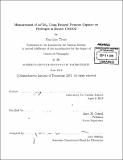Measurement of sin² 2[theta]₁₃ using delayed neutron capture on hydrogen in Double CHOOZ
Author(s)
Terao, Kazuhiro
DownloadFull printable version (29.07Mb)
Other Contributors
Massachusetts Institute of Technology. Department of Physics.
Advisor
Janet M. Conrad.
Terms of use
Metadata
Show full item recordAbstract
Double CHOOZ is a reactor antineutrino experiment built to measure [theta]13. The experiment is designed to use two detectors at different baselines (400 m and 1 km) to precisely measure the disappearance of ve from the Chooz reactor cores in Ardenne, France. Our inverse beta decay (IBD) signal is a two-fold coincidence of a prompt positron followed by a delayed neutron capture on gadolinium. The delayed neutron capture releases 8 MeV of energy from multiple gamma rays and is easily distinguished from natural radioactive backgrounds. While delayed neutron capture on gadolinium is used in all the reactor-based [theta]13 measurements [1, 2, 3], it is also possible to detect IBD via delayed neutron capture on hydrogen. In Double CHOOZ the Hydrogen detection channel has twice the signal statistics as the gadolinium detection channel, and provides an independent data sample with which to cross-check the gadolinium analysis result. The first result [4] is found to be sin² 2[theta]₁₃ = 0.097 ± 0.034 (stat) ± 0.034 (syst). The author lead the collaboration to make this measurement possible, and the detail of the work is presented in this document.
Description
Thesis (Ph. D.)--Massachusetts Institute of Technology, Dept. of Physics, 2013. In title on title-page, "[theta]" appears as the lower-case Greek letter. Cataloged from PDF version of thesis. Includes bibliographical references (pages 199-204).
Date issued
2013Department
Massachusetts Institute of Technology. Department of PhysicsPublisher
Massachusetts Institute of Technology
Keywords
Physics.